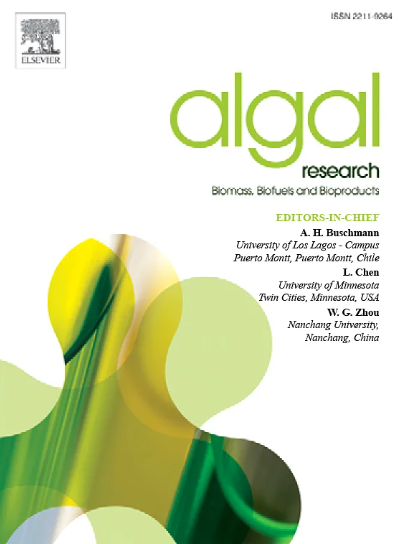Physiological, transcriptomic and metabolomic responses of the marine diatom Phaeodactylum tricornutum to the auxin IAA
IF 4.6
2区 生物学
Q1 BIOTECHNOLOGY & APPLIED MICROBIOLOGY
Algal Research-Biomass Biofuels and Bioproducts
Pub Date : 2025-03-08
DOI:10.1016/j.algal.2025.103993
引用次数: 0
Abstract
Auxin, an essential phytohormone, is widely used to promote plant growth and development. However, the effect of auxin on diatoms and its mechanism remain underexplored. Here, we studied the impact of the auxin indole 3-acetic acid (IAA) on the marine diatom Phaeodactylum tricornutum and the underlying molecular mechanisms. We found that 5 μg L−1 of IAA promotes the growth of P. tricornutum in a time-dependent manner, with the most pronounced effect observed after 96 h of treatment, resulting in a growth promotion rate of 10.6 %. Treatment with IAA increased the content of photosynthetic pigments, improved the photosynthetic efficiency, and decreased the activity of antioxidant enzymes. In addition, transcriptomics showed that IAA exposure leads to upregulation of a large number of differential genes (DEGs) in carbon fixation and porphyrin metabolism, several of which were verified by qPCR. Furthermore, corresponding metabolites of these pathways were also validated by metabolomic analysis. Thus, IAA exhibits growth-promotion effect on the diatom mainly through increasing photosynthetic carbon sequestration and the expression of genes in porphyrin synthesis. Our results provide key data on the action mechanism of IAA in promoting the growth of a diatom.

求助全文
约1分钟内获得全文
求助全文
来源期刊

Algal Research-Biomass Biofuels and Bioproducts
BIOTECHNOLOGY & APPLIED MICROBIOLOGY-
CiteScore
9.40
自引率
7.80%
发文量
332
期刊介绍:
Algal Research is an international phycology journal covering all areas of emerging technologies in algae biology, biomass production, cultivation, harvesting, extraction, bioproducts, biorefinery, engineering, and econometrics. Algae is defined to include cyanobacteria, microalgae, and protists and symbionts of interest in biotechnology. The journal publishes original research and reviews for the following scope: algal biology, including but not exclusive to: phylogeny, biodiversity, molecular traits, metabolic regulation, and genetic engineering, algal cultivation, e.g. phototrophic systems, heterotrophic systems, and mixotrophic systems, algal harvesting and extraction systems, biotechnology to convert algal biomass and components into biofuels and bioproducts, e.g., nutraceuticals, pharmaceuticals, animal feed, plastics, etc. algal products and their economic assessment
 求助内容:
求助内容: 应助结果提醒方式:
应助结果提醒方式:


